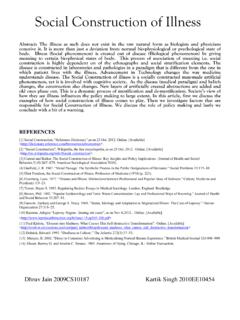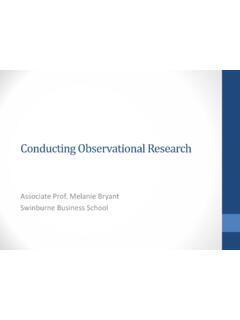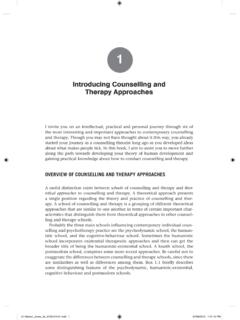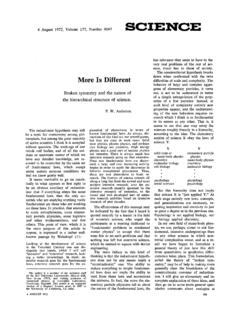Transcription of ScratchProgramming.org: An Educator's Guide to Scratch ...
1 : An Educator's Guide to Scratch ProgrammingTable of ContentsIntroduction .. use Scratch ?..4 What can I do with Scratch ?..5 Getting to scaffold learning with Scratch :..8 Creative Creativity:..14 Brainstorming Strategies:..15 Facilitating that support Scratch collaboration:..16 Programming through strategy for problem solving with multiple for facilitating multiple from with specific ideas:..33 Project Project a class generated Scratch example of a class generated Scratch rubric:.. AboutThis Guide was created by Julian Screawn. It was created in conjunction with my master's project, which is a Guide to Scratch programming for educators.
2 The purpose of the Guide is to enable Scratch educators: To create environments where students can have opportunities to develop Scratch usage and programming skills. To explore the ways in which Scratch can be used as a tool to enhance the teaching-learning process across the supports the development of 21st century learning skills such as critical thinking, problem solving, communication, collaboration, creativity and Guide will be targeted at teachers (Grade 3 and up) who wish to use Scratch as a tool for helping students develop these 21st century skills. It is hoped that the Guide will be helpful to technology teachers and subject teachers who wish to expand their tools for teaching and integrating technology.
3 Content for the Guide is based on both research and my own personal experiences as a Scratch PhilosophyOne of the main goals of the Scratch program designers was to facilitate learn by by design : Gives students greater sense of control and responsibility for the learning process. Encourages creative problem-solving. Allows for the designing of projects that are interdisciplinary(art, technology, math, and sciences). Helps kids learn to put themselves in the minds of others, since they need to consider how others will use the things they create. Provides opportunities for reflection and collaboration. Sets up a positive-feedback loop of learning, where students can build on ideas.
4 (Resnick, )This approach to learning and teaching is inspired by the constructivist and constructionist theories of learning and education. Most activities recommended in this Guide are based on the constructivist approach to use Scratch ?1. Supports the development of 21st century learning skills. According to the Scratch developers, Scratch supports the nine types of 21st century learning skills identified by the Partnership for the 21st Century ( ) ;these skills include: thinking creatively, communicating clearly, analyzing systematically, collaborating effectively, designing iteratively, and learning continuously.
5 (Rusk,Resnick,& Maloney, ).2. Supports the development of programming skills by making programming more engaging and accessible for children, teens, and others. According to the National Research Council(NRC)(1999), algorithmic thinking and programming is a 21st century skill to be learned by all It's a tool used for teaching and learning across the curriculum. According to Crook, (2009) Scratch offers the teacher an opportunity to embed the computer into everyday school activities by getting the class to develop skills in digital literacy related to a variety of curriculum It's free. Sixty-three percent of the teachers surveyed by PBS LearningMedia (2012) stated that limited budget for technology adoption was the biggest barrier to accessing technology in the can I do with Scratch ?
6 According to the Scratch homepage, Scratch is a programming language that makes it easy for users to create their own interactive stories, animations, games, music, and art -- and share their creations on the students design projects with Scratch they develop fluency with digital technology using the skills that will be needed for the 21st : Simulations: demonstrate concepts by imitating something that is done in reality. For example a probability simulation, such as a coin or dice toss experiment. See video for a probability demonstration. Multimedia: create interactive puzzles, quizzes, demonstrations and class presentations.
7 See video for a quiz demonstration. Music: create interactive instruments, music videos, or games that prompt students to play notes in the correct order. See video for a saxophone demonstration. Art: create interactive and non-interactive art projects. See video for a Math Art demonstration. Storytelling and Journals: create interactive stories or animations to support students narrative and creative writing skills. See video for an interactive story demonstration. Role play:role play real world professions, for example pretending to be a game designer and design a new StartedStart HereNew to ScratchFrom the Scratch Scratch : the Scratch introductory Guide : Scratch introduction videos: User4.
8 All videos and activities that were created for this Guide are associated with a dodge ball game that was created in Scratch . It is recommended that users spend some time reviewing the dodge ball game before reading through this website Guide . To download the dodge ball game: Tip: If you wish to have Scratch open while viewing the scaffolding "How to" videos on this site then split your screen between Scratch and your web to split your screen: Mac users: , Windows users: The screen can also be resized SkillsScaffolding ActivitiesLike training wheels computer scaffolding enables learners to do more advanced activities and to engage in more advanced thinking and problem solving than they could without such help.
9 (NRC, 2000, )One of the best ways to introduce Scratch is to give students a set of fun challenges that scaffold their learning of basic concepts and to (Alber,2011) "Scaffolding is breaking up the learning into chunks and then providing a tool, or structure, with each chunk" (par. 2).How to scaffold learning with Scratch : Start with an interesting level appropriate Scratch game,animation or project and break it up into chunks(challenges or explorations). Provide support (teacher does student watches/helps) and a challenge (student does teacher watches/helps) for each chunk. Create objectives for each chunk. Challenges can be completed individually, in pairs or example:Students will create the dodge ball game below with : Each challenge should be designed to introduce a new skill or concept.
10 Challenges should be sequenced from the easy to more difficult in a way where they build on each other to complete a project (game, animation, story, etc.). Challenges don't always necessarily need to be done in order. Solutions to challenges may following table breaks the dodge ball game up into learning chunks:ChunkSupportChallengeScreen PositionIntroduce: Position on the screen. Position variables. Xy coordinate Get the cat to say its screen address(position) using the following blocks:system. Directed to video: : Challenge: Solution: : Sprite Direction. Measurement of angles. Outcomes of the random data process in to video: the cat to say its current direction and position.





